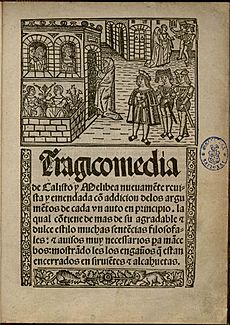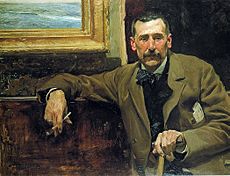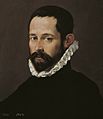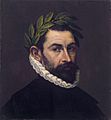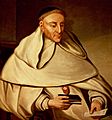Spanish literature facts for kids
Spanish literature means all the amazing stories, poems, and plays written in the Spanish language in Spain. It has grown and changed a lot over many centuries, often mixing with other cultures like Catalan, Galician, Latin, Jewish, and Arabic traditions from the Iberian peninsula. Spanish literature also includes a huge branch from Spanish America, which has its own special history.
Contents
- A Journey Through Spanish Literature
- Ancient Roots: Before the Middle Ages
- Medieval Spanish Stories: A Mix of Cultures
- The Renaissance: A New Beginning (15th-16th Centuries)
- The Baroque: Drama and Deep Thoughts (17th Century)
- The Enlightenment: Reason and New Ideas (18th Century)
- Romanticism: Feelings and Freedom (Early 19th Century)
- Realism: Life as It Is (Late 19th Century)
- Modernism: New Ways of Thinking (Late 19th - Early 20th Century)
- 20th Century Literature: Change and Turmoil
- Contemporary Literature: Today's Voices
- Images for kids
A Journey Through Spanish Literature
Let's take a quick trip through the history of Spanish writing, from ancient times to today!
Ancient Roots: Before the Middle Ages
When the Romans came to Spain around 200 BC, they brought their Latin culture. Famous Roman writers like Seneca, Martial, and Lucan were born in Spain. Even after the Roman Empire faded, writing in Spain continued in a Roman style. A very important work from this time is Etymologiae by Saint Isidore of Seville (around 560–636 AD), which tried to collect all the knowledge of the ancient world.
Then, in 711 AD, Muslim invaders arrived, bringing cultures from the Middle and Far East. This led to a time of different religions living together, and writers like the Jewish thinker Maimonides and the Muslim scholar Averroes wrote important books on science, philosophy, and math. While their works weren't directly Spanish literature, they created a rich environment for new Spanish writing to begin.
Medieval Spanish Stories: A Mix of Cultures
In the Middle Ages, Spanish literature started to truly take shape. It was a cool mix of Muslim, Jewish, and Christian cultures.
Poems from Al-Andalus
During the time of Al-Andalus (Muslim rule in Spain from 711 to 1492), much literature was written in Arabic. Jewish poets also wrote in Judeo-Arabic or Hebrew. Important writers like Ibn Arabi and Ibn Zaydún created beautiful works.
The Kharjas: Early Spanish Poems
The very first examples of Spanish-like poems are called Jarchas. They were short poems from the 9th to 12th centuries, written in local Spanish dialects but using Arabic letters. These poems usually appeared at the end of longer Arabic or Hebrew poems. They often expressed a woman's feelings about love and loss. The discovery of the Jarchas shows how diverse and rich Spanish culture was from the very beginning.
The Story of El Cid
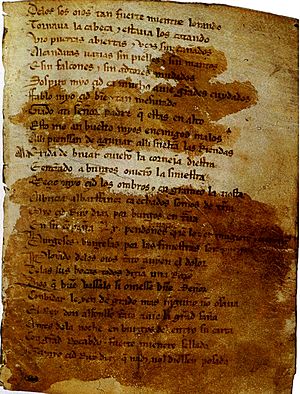
One of the most famous medieval Spanish works is the epic poem Cantar de Mio Cid. It was written around 1140 and tells the story of a real hero, El Cid. This poem is known for being very realistic, showing battles and daily life without exaggerating things or adding magical creatures. It uses a special kind of verse called mester de juglaria, which means "minstrel's craft," and was sung by traveling performers.
Mester de Clerecía: Learned Poetry
In the 13th century, a new style of poetry became popular, called Mester de Clerecía. This was written by educated poets, often priests (clerics). Their poems were more formal and focused on Christian stories, lives of saints, and tales from ancient times. Gonzalo de Berceo was a key writer in this style.
Spanish Prose: Stories in Everyday Language
Spanish prose, or written stories, became popular in the mid-13th century thanks to King Alfonso X of Castile. He supported writers and helped create many works, including Las siete partidas, which was the first modern law book written in the language people spoke. His nephew, Don Juan Manuel, wrote El Conde Lucanor, a famous collection of short stories where a wise advisor tells tales to help a count.
The Renaissance: A New Beginning (15th-16th Centuries)
The 15th century was a time of great growth in literature. The Middle Ages ended with La Celestina by Fernando de Rojas, a very important play.
The Renaissance brought new ideas from classical Greece and Rome. Writers focused on:
- Simple Language: They wanted clear, natural language, not overly fancy words.
- Themes: Love (often seen as pure and ideal), nature (peaceful and beautiful), and ancient myths were popular.
- Famous Sayings:
* Carpe Diem: "Seize the day!" – enjoy life now. * Beatus Ille: Praising quiet country life over busy city life. * Locus Amoenus: Describing nature as a perfect, lovely place.
Important writers included poets like Garcilaso de la Vega and religious writers like Santa Teresa de Jesús. The first Spanish novels, like Lazarillo de Tormes, also appeared.
The Baroque: Drama and Deep Thoughts (17th Century)
The 17th century was the Baroque era, known for its dramatic and intense style. This period is also called the Spanish Golden Age of literature.
- Key Writers: Francisco de Quevedo and Baltasar Gracián wrote important prose. Playwrights like Lope de Vega, Pedro Calderón de la Barca, and Tirso de Molina created amazing theater.
- Miguel de Cervantes: This is the era of Miguel de Cervantes Saavedra, famous for his masterpiece Don Quixote de la Mancha. This novel changed how stories were told and became a model for many writers.
- Baroque Style: It used exaggerated movement and clear details to create excitement and grandeur.
- Themes:
* Pessimism: A feeling that the world wasn't perfect, with wars and problems. * Disillusionment: Losing hope in old ideals. * Passing Time: A worry about how quickly time goes by.
The Enlightenment: Reason and New Ideas (18th Century)
The 18th century brought the Enlightenment, focusing on reason and logical thinking.
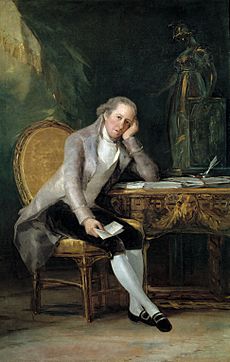
- Prose: Writers like Feijoo, Gaspar Melchor de Jovellanos, and José Cadalso wrote essays and critical works.
- Poetry: Poets like Juan Meléndez Valdés focused on clear, simple language.
- Theater: Playwrights like Leandro Fernández de Moratín wrote plays that often taught moral lessons.
This period had three main phases:
- Anti-Baroque: Writers moved away from the overly fancy Baroque style.
- Neoclassicism: They imitated ancient Greek and Roman writers, focusing on order and rules.
- Pre-Romanticism: Towards the end of the century, writers started to show more personal emotions, hinting at the next big movement.
Romanticism: Feelings and Freedom (Early 19th Century)
Romanticism was a reaction against the strict rules of the Enlightenment. It emphasized strong emotions, imagination, and individuality.
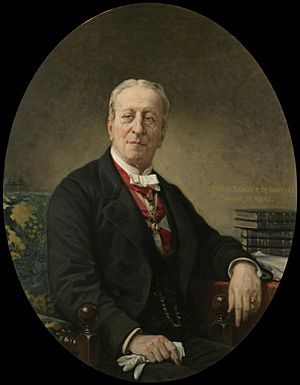
- Poetry: José de Espronceda and Rosalía de Castro were famous poets.
- Prose: Historical novels and journalism became popular. Mariano José de Larra was a notable journalist.
- Theater: Playwrights like Ángel de Saavedra (Duke of Rivas) and José Zorrilla created dramatic works.
- Key Ideas:
* Rejecting Rules: Romantics broke away from old literary rules, mixing different styles. * Subjectivity: Authors poured their feelings into their work, often showing dissatisfaction with the world. Nature often reflected their moods. * Mystery: They were drawn to dark, mysterious places like ruins and cemeteries, and to supernatural themes. * Escape: They often imagined past times (like the Middle Ages) or exotic places to escape their own world. * Themes: Passionate love, legendary stories, religion (sometimes rebellious), social issues, and nature.
Realism: Life as It Is (Late 19th Century)
Realism aimed to show life and society exactly "as they were," without romanticizing anything. It often blended with Naturalism, which explored how social conditions and environment shaped people.
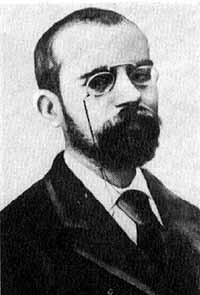
- Novels: This was a golden age for novels. Key writers included Benito Pérez Galdós, Emilia Pardo Bazán, and Leopoldo Alas (Clarín). They wrote about everyday life, marital problems, and social issues.
- Objective View: Writers tried to be objective, observing people and customs directly. They wanted the novel to be "an image of life."
- Familiar Themes: Stories often dealt with topics readers could relate to, like family conflicts.
- Everyday Language: They used popular and common language to make characters feel real.
Modernism: New Ways of Thinking (Late 19th - Early 20th Century)
Modernism in Spain was influenced by the "Disaster of '98" (when Spain lost its last colonies) and a movement called Regenerationism, which aimed to fix Spain's problems. Modernist writers felt that old art forms were outdated and needed to be changed.
- New Currents: This period saw new styles like Parnassianism (focus on beauty), Symbolism (using symbols), Futurism (focus on speed and technology), and Creationism (creating new realities in poetry).
- Key Authors: Juan Ramón Jiménez, Miguel de Unamuno, and Rubén Darío were important Modernist writers.
20th Century Literature: Change and Turmoil
The 20th century was a time of huge changes in Spain, and literature reflected these shifts.
The Generation of 1898
After Spain lost its colonies in 1898, many writers felt a deep crisis. A group of younger writers, including Miguel de Unamuno, Pío Baroja, and José Martínez Ruiz (Azorín), became known as the "Generation of 98". They explored Spanish history and identity, often expressing sadness about social injustice and political issues. Their writing changed both the style and content of Spanish literature.
The Generation of 1914
Around 1914, a slightly younger group of writers emerged. They had more formal education and approached national questions with more distance. Leading voices included the poet Juan Ramón Jiménez (who won the Nobel Prize in 1957) and the essayist José Ortega y Gasset. They often wrote essays and articles, and their tastes were more European.
The Generation of 1927
Around 1920, a group of mostly poets started publishing. They were very experimental and often tied to universities. Famous poets included Federico García Lorca, Pedro Salinas, and Vicente Aleixandre. Their work is considered a high point in Spanish literature before the Spanish Civil War.
The Spanish Civil War and Its Impact
The Spanish Civil War (1936-1939) had a terrible effect on Spanish writing. Many writers died or had to leave the country. Miguel Hernández was a notable poet who fought and wrote during the war, later dying in prison.
Literature During the Dictatorship (1939–1975)
After the Civil War, under dictator Francisco Franco, literature was often censored. Early works tried to reflect Franco's vision, but soon, writers like Camilo José Cela (who won the Nobel Prize in 1989) and Carmen Laforet started to show the real struggles of Spanish society, often in a subtle way to avoid censorship.
By the mid-1950s, a new generation of writers who grew up during the war began to write. They focused on social realism, showing the "truth" of life under Franco. Later, in the 1960s, Spanish authors started experimenting again, influenced by new styles from France and Latin America. Novels like Luis Martín Santos's Tiempo de silencio were very important.
Writing in Democracy (1975–1999)
When Franco died in 1975, Spain became a democracy, and this had a big impact on literature. Writers wanted to tell engaging stories again. Eduardo Mendoza's La verdad sobre el caso Savolta (1975) was a key book that combined experimental ideas with exciting storytelling.
Many new writers like Juan José Millás, Rosa Montero, and Javier Marías became popular. Spanish novels started appearing on best-seller lists, and many writers became famous. By the 1990s, literary prizes became very important, often giving large sums of money to winning authors. Writers like Arturo Pérez-Reverte became literary superstars, with many of their novels turned into films.
Contemporary Literature: Today's Voices
Today, Spanish literature continues to thrive. Javier Marías is considered one of the most important contemporary authors. Other widely read writers include Enrique Vila-Matas, Rosa Montero, and Antonio Muñoz Molina. Popular authors like Carlos Ruiz Zafón have also gained international fame. Newer voices like Elvira Navarro and Javier Cercas are also publishing acclaimed best-selling novels.
Images for kids
-
El escritor José de Espronceda, portrait by Antonio María Esquivel (around 1845) (Museo del Prado, Madrid)
Madrid es una ciudad de más de un millón de cadáveres (según las últimas estadísticas).
A veces en la noche yo me revuelvo y me incorporo en este nicho en el que hace 45 años que me pudro,
y paso largas horas oyendo gemir al huracán, o ladrar los perros, o fluir blandamente la luz de la luna.
Y paso largas horas gimiendo como el huracán, ladrando como un perro enfurecido, fluyendo como la leche de la ubre caliente de una gran vaca amarilla.
Y paso largas horas preguntándole a Dios, preguntándole por qué se pudre lentamente mi alma,
por qué se pudren más de un millón de cadáveres en esta ciudad de Madrid,
por qué mil millones de cadáveres se pudren lentamente en el mundo.
Dime, ¿qué huerto quieres abonar con nuestra podredumbre?
¿Temes que se te sequen los grandes rosales del día, las tristes azucenas letales de tus noches?
La familia de Pascual Duarte Nada La sombra del ciprés es alargada La noria El jarama Los bravos Entre visillos El fulgor y la sangre Juegos de manos Canto a España A la inmensa mayoría La poesía es un arma cargada de futuro c. 560–636 c. 1845  In Spanish: Literatura española para niños
In Spanish: Literatura española para niños
- Latin American literature
- Philippine literature in Spanish
- List of Spanish-language authors
- List of Spanish-language poets
- Catalan literature
- Galician-language literature
- List of Asturian language authors
- The Premio Cervantes prize is awarded to honour the career of a writer in the Spanish language, regardless of nationality.
- José María Gironella
- Arabic literature, for literature produced in Islamic Spain



